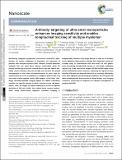| dc.contributor.author | Nguyen, Hung V. -T. | |
| dc.contributor.author | Johnson, Jeremiah A. | |
| dc.date.accessioned | 2020-04-24T13:37:10Z | |
| dc.date.available | 2020-04-24T13:37:10Z | |
| dc.date.issued | 2019-09 | |
| dc.date.submitted | 2019-07 | |
| dc.identifier.issn | 2040-3364 | |
| dc.identifier.issn | 2040-3372 | |
| dc.identifier.uri | https://hdl.handle.net/1721.1/124848 | |
| dc.description.abstract | Monitoring malignant progression and disease recurrence post-therapy are central challenges to improving the outcomes of patients with multiple myeloma (MM). Whereas current detection methods that rely upon bone marrow examination allow for precise monitoring of minimal residual disease and can help to elucidate clonal evolution, they do not take into account the spatial heterogeneity of the tumor microenvironment. As such, they are uninformative as to the localization of malignant plasma cells and may lead to false negative results. With respect to the latter challenge, clinically-available imaging agents are neither sufficiently sensitive nor specific enough to detect minute plasma cell populations. Here, we sought to explore methods by which to improve detection of MM cells within their natural bone marrow environment, using whole-animal magnetic resonance imaging to longitudinally monitor early-stage disease as well as to enhance tumor detection after systemic therapy. We conducted a proof-of-concept study to demonstrate that ultra-small (<5 nm) gadolinium-containing nanoparticles bound to full-length antibodies against the B-cell maturation antigen (BCMA) exhibit rapid tumor uptake followed by renal clearance, improving the signal-to-noise ratio for MM detection beyond levels that are currently afforded by other FDA-approved clinical imaging modalities. We anticipate that when combined with bone marrow or blood biopsy, such imaging constructs could help to augment the effective management of patients with MM. ©2019 | en_US |
| dc.language.iso | en | |
| dc.publisher | Royal Society of Chemistry (RSC) | en_US |
| dc.relation.isversionof | 10.1039/c9nr06512a | en_US |
| dc.rights | Creative Commons Attribution Noncommercial 3.0 unported license | en_US |
| dc.rights.uri | https://creativecommons.org/licenses/by-nc/3.0/ | en_US |
| dc.source | Royal Society of Chemistry (RSC) | en_US |
| dc.title | Antibody-targeting of ultra-small nanoparticles enhances imaging sensitivity and enables longitudinal tracking of multiple myeloma | en_US |
| dc.type | Article | en_US |
| dc.identifier.citation | Detappe, Alexandre, et al., "Antibody-targeting of ultra-small nanoparticles enhances imaging sensitivity and enables longitudinal tracking of multiple myeloma." Nanoscale 11, 43 (Sept. 2019): no. 20485 doi 10.1039/c9nr06512a ©2019 Author(s) | en_US |
| dc.contributor.department | Massachusetts Institute of Technology. Department of Chemistry | en_US |
| dc.relation.journal | Nanoscale | en_US |
| dc.eprint.version | Final published version | en_US |
| dc.type.uri | http://purl.org/eprint/type/JournalArticle | en_US |
| eprint.status | http://purl.org/eprint/status/PeerReviewed | en_US |
| dc.date.updated | 2019-11-25T20:54:24Z | |
| dspace.orderedauthors | Alexandre Detappe; Mairead Reidy; Yingjie Yu; Clelia Mathieu; Hung V.-T. Nguyen; Thibaud P. Coroller; Fred Lam; Petr Jarolim; Peter Harvey; Andrea Protti; Quang-De Nguyen; Jeremiah A. Johnson; Yannick Cremillieux; Olivier Tillement; Irene M. Ghobrial; P. Peter Ghoroghchian | en_US |
| dspace.date.submission | 2019-11-25T20:54:27Z | |
| mit.journal.volume | 11 | en_US |
| mit.journal.issue | 43 | en_US |
| mit.metadata.status | Complete | |
